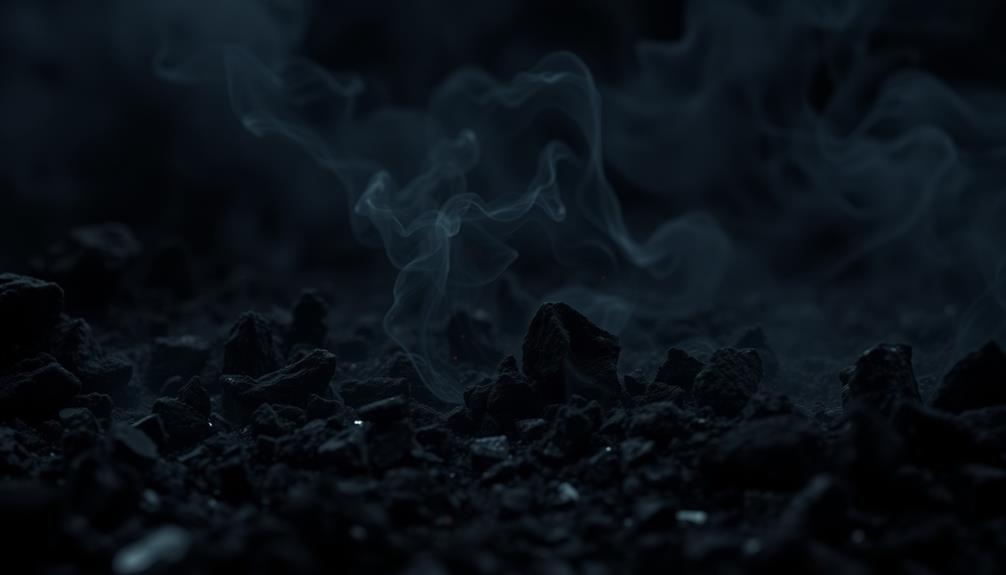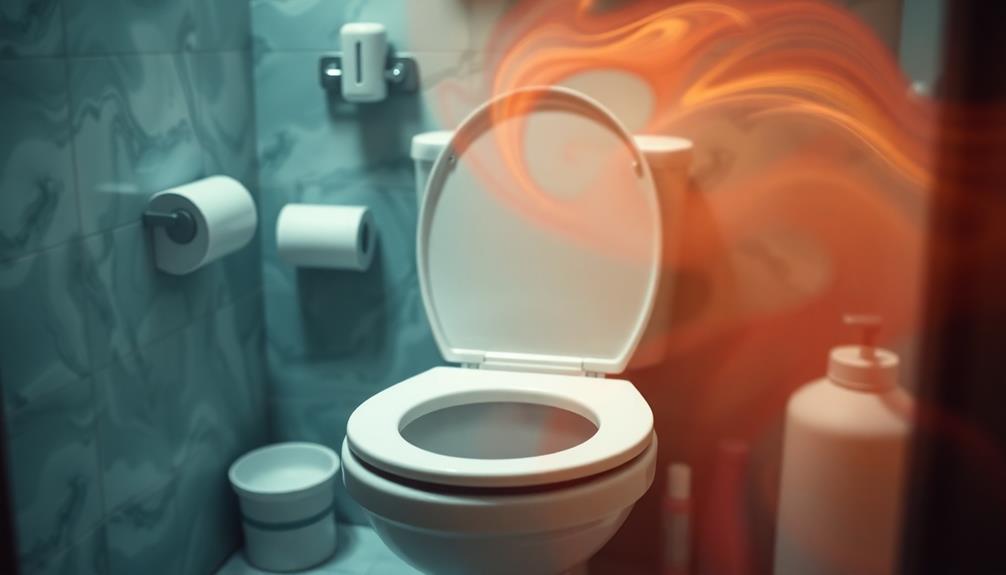Ammonia has a sharp, pungent smell that hits you immediately. It's often compared to the odor of cat urine or decomposing organic matter, and it can be quite overwhelming. This distinctive aroma is easily recognizable and is strongest in places like farms or near animal waste. You might encounter it in household cleaners, too. The smell intensifies in warm temperatures and higher concentrations, making it even more noticeable. If you want to know why ammonia has such a powerful scent and its implications, there's more to discover that'll answer your questions.
Key Takeaways
- Ammonia has a sharp, pungent odor often described as chemical-like, similar to cat urine.
- The smell intensifies with higher concentrations and warmer temperatures.
- It is commonly associated with decomposing organic matter and animal waste.
- Ammonia is found in household cleaning products, especially glass cleaners.
- In agricultural settings, such as barns and stables, the strong odor is particularly noticeable.
Introduction

Understanding what ammonia smells like can help you recognize it in various situations, whether it's in cleaning products or the aftermath of pet accidents. Ammonia has a sharp, pungent odor that many people find overwhelming. If you've ever caught a whiff of cat urine or fresh animal waste, you've likely experienced that distinctive ammonia smell. While fresh urine might not be as strong, the odor intensifies as it decomposes, releasing more ammonia into the air.
You may notice that concentrated forms of ammonia, often found in cleaning products, emit a particularly harsh and irritating smell. This can cause irritation to your eyes, nose, and throat if inhaled, so it's essential to handle these products with care. Understanding this odor can help you distinguish it from other smells around your home.
Recognizing ammonia's presence can alert you to potential issues, such as pet accidents or the need for more thorough cleaning. By being aware of the ammonia smell and its sources, you can maintain a cleaner, more comfortable living environment while ensuring your safety.
Description of the Smell

The smell of ammonia is unmistakable and often described as sharp and pungent, reminiscent of cat urine or fish. This odor is easily detectable, especially in concentrated forms, where it can become overwhelming. When you catch a whiff of ammonia, you might find it has a harsh, chemical-like quality that can evoke memories of strong cleaning products.
As fresh urine decomposes, the smell of ammonia intensifies, turning from a mild scent into something more potent and irritating. In high concentrations, ammonia can cause irritation to your eyes, nose, and throat, leading to discomfort that's hard to ignore.
You might also notice that ammonia's pungent odor can remind you of burnt matches or even rotting organic matter. This distinct smell is not only unpleasant but serves as a warning of the chemical's presence. Overall, the odor of ammonia is one that lingers in the air, leaving a strong impression on anyone who encounters it. Whether you're dealing with cleaning products or natural sources, the smell of ammonia is a characteristic you're unlikely to forget.
Source and Composition

Ammonia originates from both natural and industrial processes, making it a common presence in our environment. This colorless gas, with the chemical formula NH3, consists of nitrogen and hydrogen. Its distinctive odor is sharp and pungent, often likened to the smell of fish or cat urine, which you can easily detect even in low concentrations.
In nature, ammonia is produced through the decomposition of organic matter, particularly from animal waste. During this process, urea breaks down, releasing ammonia gas as a waste product. This natural occurrence highlights the role of ammonia in the ecosystem, as it contributes to nutrient cycling.
On the industrial side, ammonia is prevalent in various applications, including fertilizers and cleaning products. These chemical processes lead to its widespread presence, making ammonia a familiar scent in many households. You may notice its strong smell in concentrated forms, such as stagnant urine or ammonia-based cleaners. However, be cautious, as inhaling high concentrations can irritate your respiratory system. Understanding ammonia's sources and composition helps explain why its odor is so pervasive in our daily lives.
Typical Scenarios or Environments

In everyday life, you'll encounter ammonia's strong odor in various typical scenarios and environments. One of the most common places is around animal waste, especially on farms or in stables, where the decomposition of urine releases a pungent scent. If you've ever been near a litter box, you might have noticed that unmistakable smell similar to cat urine, which is also a form of ammonia.
In your home, ammonia is often present in cleaning products, particularly in glass cleaners and disinfectants. When you use these products, you may catch a whiff of that sharp odor, which can be quite overpowering.
Industrial environments also frequently exhibit ammonia's strong scent. Whether it's in fertilizer production, refrigeration processes, or waste treatment facilities, the fumes can be intense. Furthermore, in areas with stagnant water or decomposing organic matter, the odor becomes more concentrated, revealing its fish-like aroma.
Whether you're in a barn, cleaning your windows, or passing by an industrial facility, ammonia's pungent odor is hard to ignore, reminding you of its presence in various environments.
Emotional or Cultural Associations

Many people associate the smell of ammonia with cleanliness and freshness, thanks to its prevalence in household cleaning products. This perception of freshness can evoke a sense of order and hygiene in your environment. However, the pungent smell of ammonia can also trigger negative emotional responses, like discomfort or nausea, especially in high concentrations.
You might find that this unpleasant odor connects to specific memories, such as visits to animal care facilities or industrial settings where ammonia is common. In these contexts, it can represent not only cleanliness but also potential unhygienic conditions, altering your reaction to its scent.
Cultural beliefs play a significant role in shaping how you perceive the smell of ammonia. In traditional medicine, it's often used as a diagnostic tool, with its presence in urine indicating various health conditions. This association reinforces its importance in discussions about bodily functions and health. Ultimately, your emotional and cultural associations with ammonia's smell can vary widely, influenced by both your personal experiences and broader societal beliefs about cleanliness and health.
Health or Safety Considerations

The strong smell of ammonia, often tied to feelings of cleanliness, can quickly shift to concern when considering health and safety. Inhaling concentrated ammonia can lead to respiratory irritation, resulting in symptoms like coughing, wheezing, and shortness of breath. High concentrations of ammonia fumes can severely damage your eyes, nose, throat, and lungs, requiring immediate medical attention.
Even mild exposure can irritate your mucous membranes, which underscores the importance of proper ventilation when using ammonia-based products. Since ammonia is classified as a hazardous substance, its use in industrial settings is strictly regulated to safeguard workers and the environment from harmful exposure.
To mitigate health risks, you should follow essential safety precautions when handling ammonia. This includes wearing protective gear such as gloves and masks, and ensuring adequate airflow in enclosed spaces. Always be aware of how exposure to ammonia can affect you, and don't underestimate the need for precautionary measures. By prioritizing safety, you can significantly reduce the potential dangers associated with ammonia and protect your health in the process.
Final Thoughts

Understanding ammonia's characteristics and potential hazards is crucial for anyone who encounters this compound. The ammonia smell, known for its sharp odor, can be overwhelming and is easily recognizable. You might associate it with urine decomposition, as fresh urine has a milder scent that intensifies due to the breakdown of urea into ammonia. This pungent scent is often compared to that of fish, cat urine, or strong cleaning products.
While low concentrations of ammonia are detectable, high concentrations can pose significant risks. Exposure to these elevated levels may lead to irritation of the eyes, nose, and throat, and can even result in respiratory issues if inhaled. It's essential to recognize this chemical-like smell and understand its association with organic matter breakdown, especially in environments like stables or areas with animal waste.
Frequently Asked Questions
How Would You Describe the Smell of Ammonia?
When you encounter ammonia, you might describe its smell as sharp and pungent. It often hits you like a blast, reminiscent of burnt matches or something unpleasant like rotting eggs. You can detect it even in low concentrations, which can be overwhelming. If you're near a source of high concentration, you might feel irritation in your eyes, nose, or throat, making the experience even more intense and uncomfortable.
What Else Smells Like Ammonia?
You might notice several things that smell like ammonia. For instance, concentrated urine, especially from pets, can give off a pungent odor. Certain cleaning products, particularly those containing ammonia, can also emit a sharp scent when you use them. Additionally, decomposing organic matter, like animal waste or spoiled food, often releases similar smells. Fertilizers rich in nitrogen can contribute to this odor too, especially during improper storage or decomposition.
What Does Urine Ammonia Smell Like?
When you encounter urine with a strong ammonia smell, you'll notice it's sharp and pungent, often reminiscent of cat urine or fish. This odor becomes more intense if you're dehydrated or on a high-protein diet. Fresh urine typically smells less like ammonia, but as it decomposes, the scent grows stronger. If you notice this change frequently, it might be worth checking for possible health issues like urinary tract infections or kidney problems.
How Does Ammonia Breath Smell Like?
When you encounter ammonia breath, you'll likely notice a sharp, pungent odor that's hard to ignore. It often reminds you of cat urine or spoiled fish, making it quite distinct. This smell can arise due to various factors, like high protein intake, dehydration, or underlying health issues. If you're experiencing this odor frequently, it's crucial to consult a healthcare professional to rule out any serious conditions that might be causing it.









